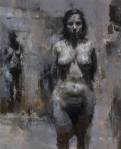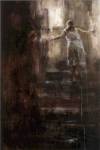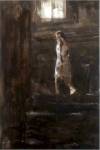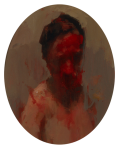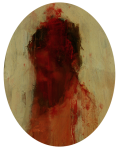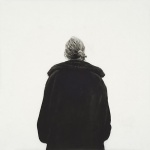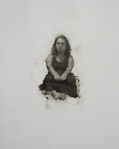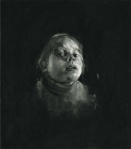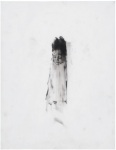I came across some additional images of Sophie Jodoin‘s earlier works this past week, and it happened at a time when I really felt like I needed to see something that speaks of blunt honesty. I have been thrown a lot of curve balls during my experience in Israel, so it is consoling and encouraging to look at an artist that attempts to expose the learned truth, straightforward without agenda or masks, focusing on the victims rather than the crazed protagonists.

From The Fallen (revisited) series, 2006
Jodoin has explored numerous difficult themes over the years, particularly the violences in war, children, relationships, growing up and aging, as well as the feelings of numbness, nostalgia, fear, rejection, and aspirations that accompany these very facts of human existence. Around 2003, and certainly by her Fallen (revisited) series in 2006, Jodoin chose to remove color altogether from her work, to strip “away the sensuality of color often associated with painting,” as she put it. The 2004 series “A Little Red Suite: the World is a Heartbreaker” – oval portraits of grief in red – were thus followed by the black and white documentary type explorations of Drawing Shadows (of her mother) and Diary of K., and since then Jodoin has consistently stuck to the raw, graphic power of black and white.

From A Little Red Suite – the World is a Heartbreaker series
Is she perhaps better skilled in black and white than color? I might say so, but then again it has been hard to find more than a few earlier works in color to compare. Reality has its base in black and white, existing before the cones and rods of the eyeball, and color does impassion our moods unwillingly – just imagine if food were only in black and white. Certainly, the lack of color in her work over the last several years lends more severity, coldness and objectiveness to the analysis, and thus is more suggestive of a documentary approach on the human condition. It also serves to curb any of those who dare classify Jodoin as a political artist; the removal of optical color also takes out any of the cloying color of politics. At any rate, I like pretty much anything she does, in any hue or tone.

Study for Homicide, date unknown
She always knocks the wind out of me, because the images have a violence in contemplation rather than in surface – a jolt of exposure that is needed, in my opinion. It is too easy to go about our day ignoring, neglecting or simply being unaware of other currents and people around us. We are so “busy.” It is only when unfortunate things happen in our own back yard that we stop for a moment and begin to fully question the horrors of being human. Sophie Jodoin paintings function like universal backyards for the viewer. Though artists tend to notice things others may not, in many of her series, Jodoin chooses to make the likeness of a person unrecognizable while focusing instead on the realism of recognizable props, which can sift out an undercurrent of emotions that perhaps we had never considered before. We do not recognize a random soldier, but we recognize the bandages of war. We may not relate to a toddler’s face, but we can relate to a faceless young girl clinging to a bunny.

From the Ward Series 2008-09
Jodoin allows us views of people who – by a rare slip of circumstance – are not us, but could be us in a split second. We should not be fooled that we are better or more fortunate than anyone else simply because we are standing on the other side of the glass. Instead, we can absorb these works as exposures of the fragile, haunting truthfulness of life, and we can walk away more equipped to proceed with life, with more knowledge and compassion.
Born in 1965, Jodoin lives and works in Montreal, having earned her BFA from Concordia University in Montreal in 1988. Represented by Battat Contemporary and Newzones Gallery of Contemporary Art, she exhibits regularly throughout Canada, the US and Europe. Her website provides a thorough investigation of her work and bibliography since 2004. There is a also a beautiful filmed interview (in French) of Sophie and her work.



































































